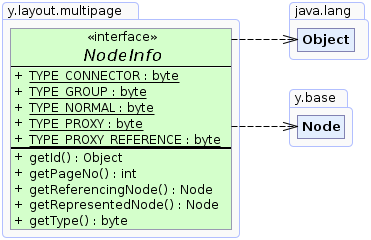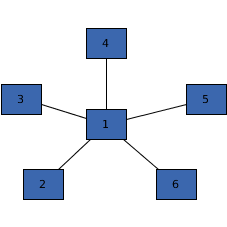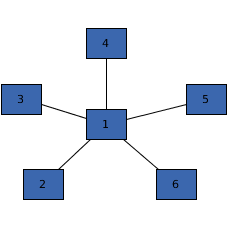
|
Search this API | ||||||||
| PREV CLASS NEXT CLASS | FRAMES NO FRAMES | ||||||||
| SUMMARY: NESTED | FIELD | CONSTR | METHOD | DETAIL: FIELD | CONSTR | METHOD | ||||||||
public interface NodeInfo
This interface offers access to information associated with a node.
The information can be either obtained from MultiPageLayout.getNodeInfo(Node) or
LayoutContext.getNodeInfo(Node).

| Field Summary | |
|---|---|
static byte |
TYPE_CONNECTOR
A node type that specifies a connector node. |
static byte |
TYPE_GROUP
A node type that specifies a group node. |
static byte |
TYPE_NORMAL
A node type that specifies a normal node. |
static byte |
TYPE_PROXY
A node type that specifies a proxy node. |
static byte |
TYPE_PROXY_REFERENCE
A node type that specifies a proxy reference node. |
| Method Summary | |
|---|---|
java.lang.Object |
getId()
Returns the unique ID of the node associated with this info object. |
int |
getPageNo()
Returns the page number of the page graph
that contains the node associated with this info object. |
Node |
getReferencingNode()
Returns the node that refers to the one associated with this info object. |
Node |
getRepresentedNode()
Returns the node of the input graph that is represented by the node associated with this info object. |
byte |
getType()
Returns the type of the node associated with this info object. |
| Field Detail |
|---|
static final byte TYPE_NORMAL
A node is called normal if it does not belong to any other type.
getType(),
Constant Field Valuesstatic final byte TYPE_GROUP
A group node is a node that may contain other nodes.
getType(),
Constant Field Valuesstatic final byte TYPE_PROXY
A proxy node is a copy of a normal node.
It is created by the algorithm if a normal node and its neighbors or associated
connectors do not fit onto a single page. Hence, in such cases, the neighbors/connectors
associated with a normal node may be distributed among different proxy nodes associated with this node.
normal node may be associated with multiple proxy nodes placed on different pages.getType(),
TYPE_NORMAL,
TYPE_PROXY_REFERENCE,
MultiPageLayouter.setProxyReferenceNodeCreationEnabled(boolean),
Constant Field Values The input graph. |  The result after a multi-page layout run. The second page contains a proxy for node 1.
The first page has a proxy reference (the elliptical node) that indicates that there
is a proxy of node 1 located at the second page. |
static final byte TYPE_PROXY_REFERENCE
For each proxy node there is exactly one matching proxy reference node
(except if property MultiPageLayouter.setProxyReferenceNodeCreationEnabled(boolean) is disabled).
The reference node refers to the proxy and is either connected to the normal node
associated with this proxy or one of its other proxy nodes (a normal node may be associated with multiple proxy nodes).
Hence, for a node connected to a proxy reference node there always exists a copy located on another page.
getType(),
TYPE_PROXY,
MultiPageLayouter.setProxyReferenceNodeCreationEnabled(boolean),
Constant Field Values The input graph. |  The result after a multi-page layout run. The first page has a proxy reference (the elliptical node) that indicates that there
is a proxy of node 1 located at the second page. |
static final byte TYPE_CONNECTOR
Each edge of the input graph that connects two nodes v and w
that are placed on different pages is split by a pair of matching connector nodes (one for each of the two pages).
One of the connector nodes is connected to v and the other to w.
Hence, each connector represents a jump mark to the matching connector and guarantees that no information is lost
as it would be the case if such edges are simply removed.
getType(),
Constant Field Values| Method Detail |
|---|
Node getRepresentedNode()
info object.
Note that, for the special nodes inserted to guarantee that no information is lost, there are no corresponding nodes in the input graph. Hence, special nodes are mapped to common nodes in the following way:
connector node is mapped to the common node connected to the matching connector.proxy node is mapped to the associated common node (i.e., the proxy is a copy of that node).proxy reference node is not mapped to any node, and, thus this method returns null for such nodes.
page graphs are created by the layout algorithm,
the input graph remains unchanged. Matching elements are mapped to the same
element ID, see
MultiPageLayouter.NODE_ID_DPKEY, MultiPageLayouter.EDGE_ID_DPKEY,
MultiPageLayouter.NODE_LABEL_ID_DPKEY and MultiPageLayouter.EDGE_LABEL_ID_DPKEY.
This method always returns a node of the input graph!int getPageNo()
page graph
that contains the node associated with this info object.
byte getType()
info object.
java.lang.Object getId()
info object.
MultiPageLayouter.NODE_ID_DPKEYNode getReferencingNode()
info object.
More precisely, if the node associated with this info object
connector node, this method returns the matching connector node,proxy node, it returns the corresponding proxy reference node
(or the associated common node if property MultiPageLayouter.setProxyReferenceNodeCreationEnabled(boolean)
is disabled),proxy reference node, it returns the corresponding proxy node,null.
TYPE_CONNECTOR,
TYPE_PROXY,
TYPE_PROXY_REFERENCE,
MultiPageLayouter.setProxyReferenceNodeCreationEnabled(boolean)
|
© Copyright 2000-2025, yWorks GmbH. All rights reserved. |
||||||||
| PREV CLASS NEXT CLASS | FRAMES NO FRAMES | ||||||||
| SUMMARY: NESTED | FIELD | CONSTR | METHOD | DETAIL: FIELD | CONSTR | METHOD | ||||||||